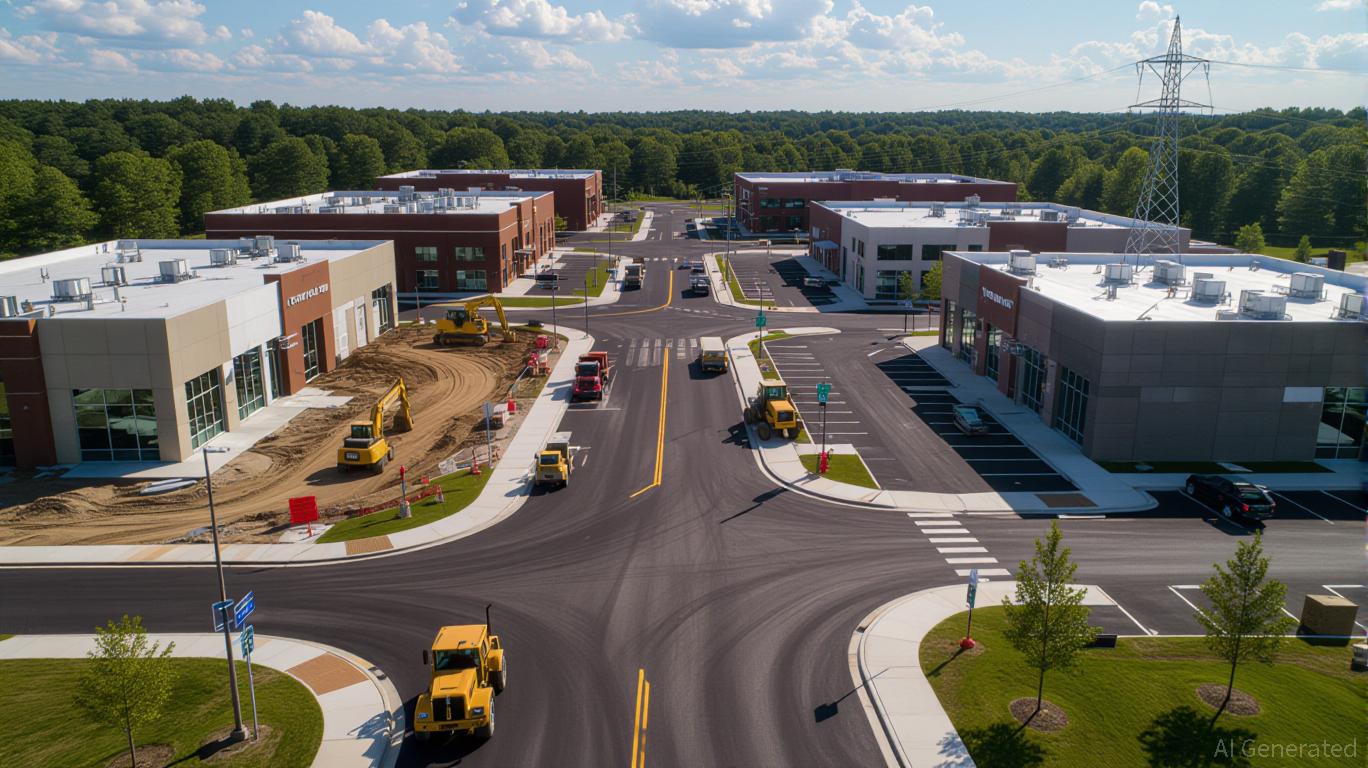The Influence of Targeted Infrastructure Funding on Property and Industrial Growth
- New York's FAST NY program allocates $9.8M to Webster for infrastructure upgrades, targeting industrial and real estate growth. - The grant funds road realignment, sewer upgrades, and electrical planning to attract $650M private investments like fairlife® dairy facility. - Webster's 10.1% residential property value surge and 300+ acres of revitalized land highlight infrastructure-driven economic multipliers. - Statewide, FAST NY has allocated $283M across 37 projects, transforming coal plants and brownfi
Strategic Infrastructure Investment: Driving Private Sector Growth
Amidst economic volatility and evolving industrial landscapes, targeted infrastructure spending has become a powerful catalyst for stimulating private sector expansion. A recent example is the $9.8 million FAST NY grant awarded to Webster, NY, which demonstrates how focused public investment can spark significant transformation in both real estate and industry. By exploring this initiative, we can better understand how infrastructure grants have the potential to reshape local economies and attract substantial private capital.
Preparing Land for Immediate Development

The FAST NY Shovel-Ready Grant Program, managed by Empire State Development, aims to accelerate the readiness of industrial sites for private enterprise. In Webster, the $9.8 million grant is being used to rejuvenate the former Xerox campus and surrounding areas through projects such as road redesign, upgrades to sanitary sewers, and planning for electrical infrastructure. These enhancements address core obstacles to development, including outdated utilities and limited transportation options, which often discourage fast-growing industries from investing.
This focus on preparing "shovel-ready" sites is especially important in today’s competitive market. By ensuring land is pre-approved and prepped for development, governments help reduce both the time and expense for businesses to set up operations. Webster is already seeing results: a $650 million fairlife® dairy facility, projected to generate 250 jobs, is scheduled to open by the end of 2025. This project highlights how infrastructure improvements can directly encourage private investment, particularly in sectors that require significant capital, such as advanced manufacturing and food production.
Wider Economic Benefits: Employment, Property Values, and Tax Revenue
The positive effects of these grants extend well beyond immediate job creation. In Webster, residential property values have climbed by 10.1% over the past year, a surge attributed to the area’s improved industrial prospects and upgraded infrastructure. Commercial real estate is also thriving, with nearly 300 acres of previously underused land now available for development, according to recent reports. This dual impact on both residential and commercial markets underscores the interconnected benefits of infrastructure-led growth.
Additionally, the FAST NY program’s support for mixed-use zoning—which blends manufacturing, logistics, and residential spaces—helps build sustainable economic communities. By reducing commuting distances and establishing local employment centers, these projects improve quality of life and help attract both talent and investment. For example, the revitalization of the Xerox campus includes plans for advanced manufacturing and semiconductor supply chain operations, aligning with the global demand for technology-driven industries.
Expanding the FAST NY Model Statewide
Webster’s progress is part of a broader trend. Since its launch, the FAST NY program has distributed over $283 million across 37 projects, revitalizing nearly 7,700 acres of industrial land throughout New York State. In Oneida County, a $32.36 million grant is supporting a site for Chobani’s $1 billion expansion, while Broome County’s $11.3 million investment is converting a former coal plant into a logistics center, according to official sources. These cases show that the program’s approach—combining infrastructure improvements with incentives for private industry—can be successfully replicated to drive growth in various regions.
Governor Kathy Hochul’s focus on developing "shovel-ready" sites reflects a strategic understanding of modern industrial requirements. By emphasizing energy-efficient utilities, robust transportation links, and scalable infrastructure, New York is positioning itself as a destination for high-tech manufacturing and clean energy projects. This strategy not only attracts major employers but also creates opportunities for smaller businesses and startups, further diversifying local economies.
Looking Ahead: Building Resilient Economies
The experience in Webster, along with the wider FAST NY initiative, illustrates that infrastructure grants are more than just financial support—they are essential tools for building resilient economies. By removing physical and regulatory barriers to development, these investments create an environment where private innovation can thrive. As global supply chains adapt and industries seek greater resilience, regions that embrace this forward-thinking model will be better positioned to compete.
For both investors and policymakers, the takeaway from Webster is clear: strategic infrastructure funding is fundamental to long-term, inclusive growth. It transforms neglected sites into engines of progress, converting public investment into private sector returns and fostering broad-based economic development. In a connected world, the ability to seize such opportunities will shape the future of industrial and real estate success.
Disclaimer: The content of this article solely reflects the author's opinion and does not represent the platform in any capacity. This article is not intended to serve as a reference for making investment decisions.
You may also like
XRP News Today: IMF Cautions That Tokenized Markets Could Face Collapse Without International Cooperation
- IMF warns tokenized markets risk destabilizing flash crashes due to rapid growth and interconnected smart contracts. - XRP highlighted as potential cross-border payment solution but not endorsed, alongside Stellar and Bitcoin-Lightning hybrid models. - Global regulators intensify oversight of tokenized assets, with ESMA, SEC, and central banks addressing governance and liquidity risks. - IMF stresses urgent need for coordinated policy frameworks to prevent fragmentation and systemic vulnerabilities in ev

Solana News Today: Avail's Nexus Mainnet: A Borderless Blockchain Ecosystem
- Avail launches Nexus Mainnet, a cross-chain infrastructure unifying liquidity across Ethereum , Solana , and EVM-compatible chains. - The platform uses intent-solver architecture and Avail DA verification to replace bridges, enabling seamless asset movement and shared liquidity. - Integrations with major chains and partners like Lens Protocol aim to streamline DeFi and trading, while $AVAIL token coordinates cross-chain transactions. - With Infinity Blocks targeting 10 GB blocks, Nexus addresses liquidit

Cardano News Today: ETFs Turn to Alternative Coins While ADA Stumbles and XLM Gains Momentum with ISO Compliance
- Franklin ETF expands holdings to include ADA , XLM, XRP , and others, reflecting institutional altcoin diversification driven by ISO 20022 compliance and SEC-approved rules. - Cardano faces short-term bearish pressure with 31% monthly decline, contrasting Stellar's bullish 2025/2030 price projections ($1.29–$6.19) fueled by RWA and cross-border payment demand. - ISO 20022 adoption (97% payment instructions) positions ADA/XLM as bridges between DeFi and traditional finance, with Ripple's ILP enhancing XLM
AI Crypto Faces a Pivotal Turn: Regulatory Demands Surpass Aspirations in 2025
